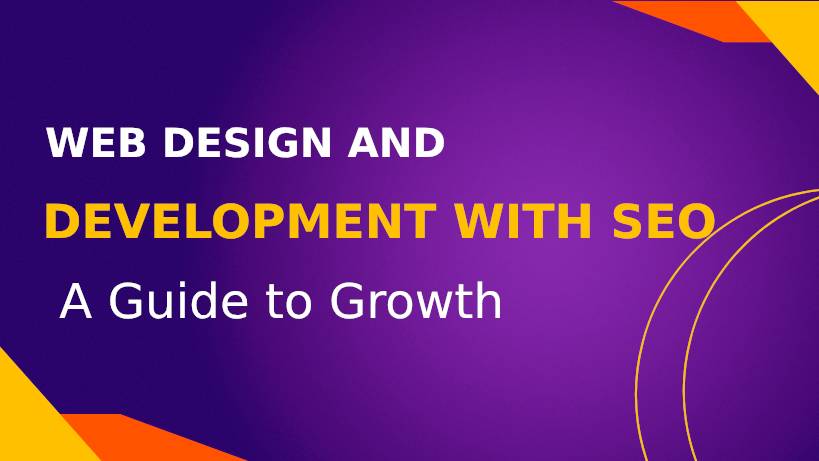
Introduction
A nicely planned, easily accessible website is essential in today's digital world. Effective SEO relies on well-optimized web design and development to enhance performance and visibility.
An SEO-friendly website is a prerequisite to drive organic traffic and top Google rankings. An effective UI/UX design implies simple usage, where the users easily navigate and conduct activities, such as purchasing products, with ease. A better User Experience (UX) is the top priority at the foundation of a website's success.
AnchorPoints offers expert web design and development and SEO services with full-service solutions to acquire a strong online presence and increase brand awareness.
Why SEO-Friendly Web Design and Development Matters?
Google's Ranking Factors Consider UX
Google's algorithms prioritize user experience (UX), rewarding websites that provide fast, accessible, and engaging experiences. Some of the core web design and development aspects that influence SEO include:
- Mobile-friendliness
- Website speed
- Intuitive navigation
- Clean, structured URLs
- High-quality content layout
Mobile-First Indexing
Google's ranking and listing system increasingly depends on a mobile-first strategy, favouring sites with mobile-friendly designs. Without a responsive, mobile-friendly site, your web design and development will not get a top spot on search engine results pages.
How to be mobile-friendly:
- Use a responsive web design
- Optimize videos and images for mobile loading
- Use readable fonts and appropriate button sizes
Critical Aspects of an SEO-Friendly Website
Website Speed Optimization
Page speed is a very important ranking signal. Slow pages lead to higher bounce rates and lower user satisfaction.
Ways for Optimizing Website Speed:
- Enable browser caching
- Use a Content Delivery Network (CDN)
- Optimize videos and images
- Minimize HTTP requests
- Use lazy loading on images
Clean and Organized URL Structure
Search engine-friendly URLs are important because they allow search engines and users to know what the page is all about.
URL structure best practices:
- Use short, descriptive URLs
- Use hyphens instead of underscores
- Avoid unnecessary numbers and symbols
- Use target keywords
Optimized Website Navigation
An organized navigation system improves crawlability, allowing search engines to index pages more easily.
Primary navigation strategies:
- Use a transparent menu structure
- Implement breadcrumb navigation
- Limit the number of clicks to access primary pages
- Include an HTML and XML sitemap
Mobile-Responsive Design
As stated above, Google favours mobile-friendly websites. A responsive design guarantees that you will have a website that responds to any screen without damaging the user's experience.
Optimized Images and Media Files
Images play a crucial role in web design but, at the same time, slow down your site unless optimized.
SEO image optimization techniques:
- Use descriptive file names
- Utilize tools such as TinyPNG or ImageOptim to compress images
- Implement lazy loading
- Use alt tags with effective keywords
HTTPS Secure Website
Google prefers secure websites. For deploying an SSL certificate for security and protection, it is essential to build trust among the users and search higher.
How to secure your site:
- Install an SSL certificate
- Keep CMS and plugins up to date
- Employ firewalls and security monitoring
Internal Linking and Anchor Text Strategy
Linking your web pages together is a fine way of making Google more efficient in terms of ranking and usability.
Best internal linking techniques:
- Employ descriptive anchor text
- Link to useful pages with quality content
- Avoid using too many links on a page
The Role of UX in SEO
Bounce Rate Reduction
A high bounce rate can inform Google that your content is boring or not highly relevant.
Ways to reduce bounce rate:
- Improve the readability of content
- Use interactive multimedia content
- Make your CTA (Call-to-Action) visible and clear
Increased Time on Site
Google considers the time people spend on your site a ranking signal.
Ways to increase dwell time:
- Use interactive content formats (videos, infographics)
- Improve internal linking to keep users engaged
- Improve readability of content with proper headings and bullet points
Creating an Accessible Website
Google prefers accessibility so that all, including individuals with disabilities, can view your site.
Enhancing website accessibility:
- Use alt tags for images
- Use ARIA (Accessible Rich Internet Applications) labels
- Ensure keyboard navigation is functioning
How AnchorPoints Can Help?
Custom SEO-Friendly Web Development
AnchorPoints is the best one to help your website thrive in SEO by embracing the best practices for user experience and proper coding structure. Within their product offering, AnchorPoints specializes in designing software solutions that solve user demand and improve system performance at the same time, which are:
- Mobile-responsive websites
- Fast-loading pages
- SEO-optimized coding structure
On-Page SEO Optimization
AnchorPoints helps businesses optimize their websites with on-page SEO that entails Meta tag optimization.
- URL construction
- Incorporation of keywords in the content
- Image and media enhancement
Web Speed and Performance Optimization
The AnchorPoints developers apply web performance measurement methodologies to speed up traffic and boost the exchange of information about their client's services and products on the web.
With their expertise in website performance optimization, they:
- Use caching methods
- Minimize CSS, JavaScript, and HTML files
- Optimize server response time
Building Sites Mobile-First
A modern site should always be built with a mobile device as the starting point; responsive design is the answer so:
- Adaptive design on every screen size
- Improved Google Mobile Usability Scores
- More engagement and conversions
Technical SEO and Site Architecture Optimization
One of the technical SEO tasks they carry out is building structured data markup to improve the appearance of search engine results pages. Their technical SEO work includes:
- Development of XML sitemap
- Robots.txt optimization
- Use of canonical tags
- Structured data markup for rich snippets
Conclusion
A well-structured website and SEO content are part of a website's good position, enhanced functionality, and success. Speed Optimization of mobile like Palm OS is one way of making the business competitive. Because search engines rank more and more on speed and mobile-friendliness, if you have an interest in marketing a product or a website, it must be the first category. Good navigation with usability factors like toast, pop-ups, and sidebar will be your business's perfect driving force. AnchorPoints ensures you receive the best SEO-friendly web design.
The experienced team of professionals will walk you through their vast collection of design and development projects, whether designing a new website or altering an existing one that needs SEO optimization. Their lasting impact is assured by how they can create your online presence on the internet and establish organic traffic to your site. Search Engine Optimization, or SEO, is an overarching process that involves optimizing a website and achieving improved rankings on popular search engines and the UX, short for the user's experience.
If you are willing to use these trends and opportunities toward better site rankings and recent user experience, request AnchorPoints.io!
Ready to enhance your website’s performance and boost your search rankings? Contact AnchorPoints today for expert web design, development, and SEO solutions






